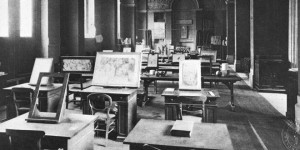
It’s because drawing is like singing – something that, if you number yourself amongst those who can’t do it, you feel a bereavement. A bereavement that only self-deprecating humour can offset: you don’t want to hear me sing. Or, from a darker place, the oblique suggestion that the nice people, the likeable ones, can’t sing: hah! of course I can’t sing…
It’s because drawing is like that that we approach it in private, and are easily driven off. A few pages at the beginning of a notebook, then the unexplored emptiness beyond.
There is, however, help at hand. Singing is another matter.
1. Drawing on the Right Side of the Brain by Betty Edwards. This classic of the early ’80s is, or should be, the first port of call for anyone setting out to change their drawing life. Edwards did two vital things with this book, and did them extraordinarily well. The first was to establish, beyond all doubt, that the problem never was that you hadn’t learned to draw: it was that you hadn’t learned to see. The second was to show you what to do about it.
The book has companion volumes – Drawing on the Artist Within, The Drawing on the Right Side of the Brain Workbook, and Color: Mastering the Art of Mixing Colors, the last of which we’ll look at in our survey of books on painting. The second edition is the one you need, as the new exercises in it build on the experience of working with the first edition.
Edwards is necessarily short on technique, but will do the vital work of getting you started.
2. John Ruskin – The Elements of Drawing
John Ruskin, author of the Three Lamps of Architecture and almost, but not quite, a Garreteer hero, opened a drawing school in Oxford in 1871. This was his textbook, and it’s now available as a free text via the Gutenberg Project:
http://www.gutenberg.org/files/30325/30325-h/30325-h.htm
The school was provided with many example drawings and paintings, which have now been brought together by Oxford’s Ashmolean Museum:
http://ruskin.ashmolean.org/welcome
This is British nineteenth century education at its very best, and for those readers who want to learn to draw properly whilst feeling themselves close to the best in Western culture, Ruskin might be a good choice. As Ruskin himself said,
..if you wish to learn drawing that you may be able to set down clearly, and usefully, records of such things as cannot be described in words, either to assist your own memory of them, or to convey distinct ideas of them to other people; if you wish to obtain quicker perceptions of the beauty of the natural world, and to preserve something like a true image of beautiful things that pass away, or which you must yourself leave; if, also, you wish to understand the minds of great painters, and to be able to appreciate their work sincerely, seeing it for yourself, and loving it, not merely taking up the thoughts of other people about it; then I can help you, or, which is better, show you how to help yourself.
3. The Natural Way to Draw by Kimon Nicolaides
Nicolaides’ excellent but altogether formidable book is the learning to draw equivalent of reading Proust in his entirety. If you come to him after Ruskin or Edwards – in other words, possessed of basic skills – and keep up with Nicolaides’ programme, you will have cause to claim truly impressive drawing skills, of the kind possessed but rarely nowadays. You would certainly be able to consider exhibiting your work to an audience, or selling it, or making some kind of living from it. Such a tough, thorough-going course was, of course, assembled before World War II, and reflects the height of art school training before the modernist revolution did for the skill of drawing across the world.
4. Draw by Jeffrey Camp
By contrast, Camp offers a playful, enthusiastic and gorgeously illustrated charge through the world of drawing – seen, in his views, as “making marks” in a meaningful way. This is a good place to come to learn expression in your drawing, to experiment with a host of modern materials and techniques, and to try your hand at reprising many of the brightest ideas in modern art. Use it as a rest cure whilst pushing yourself through Nicolaides, and you might discover something extraordinary for yourself.
